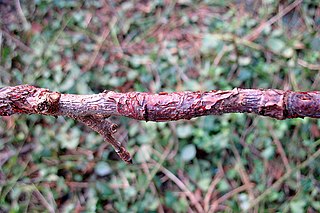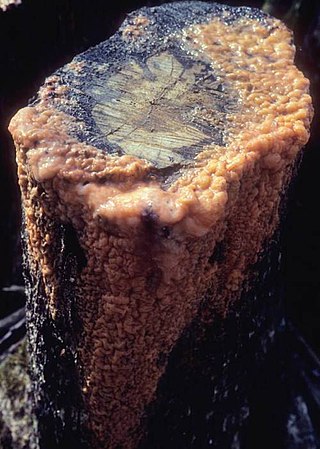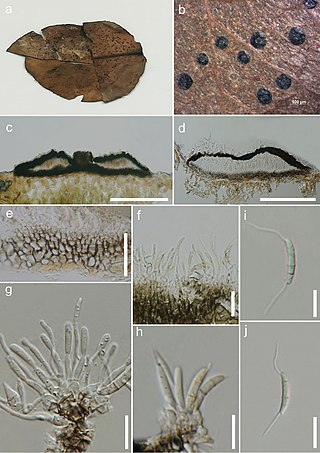
The Nectriaceae comprise a family of fungi in the order Hypocreales. It was circumscribed by brothers Charles and Louis René Tulasne in 1865. In 2020, an Outline of fungi was produced and listed 70 genera and about 1,336 species.

Phaeosphaeria is a genus of fungi in the family Phaeosphaeriaceae. It has about 95 species. The genus was circumscribed by Japanese mycologist Ichiro Miyake in 1909, with Phaeosphaeria oryzae assigned as the type species.
Alternaria penicillata is a species of fungi in the family Pleosporaceae, which causes leaf blight of opium poppy. The fungus is found in Europe, Australia, India, Japan, Nepal, Pakistan, South Africa, Turkey, USA and Zambia.

Venturia is a genus of fungi in the family Venturiaceae. First identified in 1882, species in the genus are plant pathogens. Venturia is widespread and the genus contains an estimated 58 species, or 130 species. Anamorphs were historically represented in the genus Fusicladium.

Eutypa is a genus of fungi in the family Diatrypaceae. The widespread genus was estimated to contain 32 species in 2008, and then 68 by 2023. Anamorphic forms include the genera Libertella and Cytosporina. The genus was circumscribed in 1863 by the French mycologists and brothers Louis and Charles Tulasne.

Lasionectria is a genus of fungi in the class Sordariomycetes. It consisted of six species in 2008, and 16 in 2023.
Microthyrium is a genus of fungi in the Microthyriaceae family.
Podonectria is a genus in the monotypic Podonectriaceae family of fungi. They are parasitic fungus on scale insects, other fungi, or on substrates that had previously colonized by other fungi.
Graphium is a genus of fungi in the family Microascaceae.. Historically, Graphium was used for hyphomycetes with erect, black synnemata bearing a single, terminal, ball of one-celled, hyaline conidia produced from annellides. More than 100 species were described following that general concept before the diversity of sexual states and DNA phylogenies led to reclassification of most species. The approximately 20 species remaining in the modern genus are assumed to be minor plant pathogens on trees. Most species reported in soil, plant debris, woody substrates, manure, and polluted water are now classified in other genera such as Parascedosporium or Ophiostoma.

Cosmospora is a genus of ascomycete fungi in the family Nectriaceae. The genus, as circumscribed by Rossman et al. (1998), included all the nectrioid species with small, reddish, non-ornamented sexual fruiting bodies that collapse laterally when dry. However, the genus was shown to be polyphyletic, and the majority of species were re-classified into revived or recently established genera that are monophyletic. Cosmosporasensu Rossman housed members of the following genera: Chaetopsina, Cylindrocladiella, Fusicolla, Macroconia, Mariannaea, Microcera, Pseudocosmospora, Stylonectria, and Volutella. Cosmospora was restricted to species having acremonium-like asexual morphs that grow on polypores and xylariaceous fungi by Gräfenhan in 2011. About 20 species are accepted in the genus.

Neonectria is a genus of fungi in the family Nectriaceae.

Fusicolla is a genus of seven species of ascomycete fungi in the family Nectriaceae. The genus was circumscribed by German mycologist Hermann Friedrich Bonorden in 1851. Fungi in the genus produce slimy orange sheets over the substrate, within which the perithecia can be either fully or partially immersed. Asexual spores are similar to those of Fusarium.
Clonostachys is a genus of fungi in the order Hypocreales and family Bionectriaceae.

Volutella is a genus of fungi belonging to the family Nectriaceae.
Cyanonectria is a genus of fungi belonging to the family Nectriaceae.
Dilophospora is a genus of fungi belonging to the order Dothideomycetes, in the family Sporocadaceae.
Dothidea is a genus of fungi belonging to the family Dothideaceae. The genus was first described in 1818 by Elias Magnus Fries. The type species is Dothidea sambuci.

Mariannaea is a genus of fungi belonging to the family Nectriaceae.

Stilbella is a genus of fungi in the order Hypocreales. The relationship of this taxon to other taxa within the order is unknown, and it has not yet been placed with certainty into any family. It is sometimes placed in the family Bionectriaceae.

Discosia is a genus of plant pathogens in the family Sporocadaceae.











